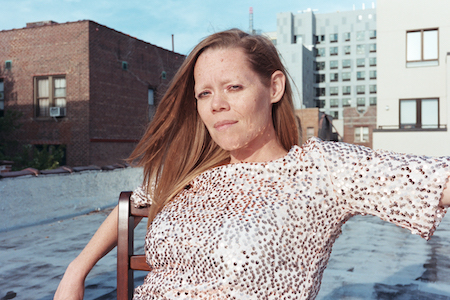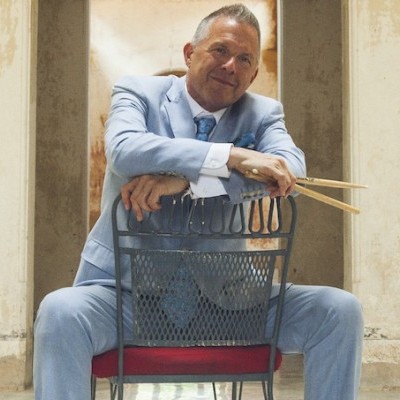Oct 28, 2025 10:47 AM
In Memoriam: Jack DeJohnette, 1942–2025
Jack DeJohnette, a bold and resourceful drummer and NEA Jazz Master who forged a unique vocabulary on the kit over his…

Caroline Davis didn’t share the concept of Portals with her fellow artists before they went into the studio.
(Photo: Attis Clopton)When she entered Oktaven Audio in 2020, Caroline Davis brought with her the enormity of a shapeshifting grief. The saxophonist and composer lost her father in the months before lockdown, and had taken up artistic residence at MacDowell, an artist residency in New Hampshire, following his funeral in Switzerland. The surrealism of that series of events accompanied solitude and wonder. “One thing that had been on my mind was trying to define those experiences of grief without relying on those that have already been defined,” said the Brooklyn-based artist.
Following solo-led releases Alula (2019) and Heart Tonic (2018), each piece in her collection of compositions that would become Portals, Volume 1: Mourning (Sunnyside Records) addresses living with death, and healing. But familiar models of grieving, namely Kübler-Ross, felt insufficient to Davis. And the peculiar way she experienced grief and mourning held center focus as she composed. “I was feeling moments of sensical softness and tactile wetness, then heaviness or hardness — kind of burlap — and then tactile spikes,” she said. “So there were moments of my experience I wanted to classify into these categories.”
While Davis sought to organize her compositions around tactile responses to grief, the pieces themselves took on lives on their own. Deliberately, she offered few instructions and little context to her fellow artists who include quintet members Marquis Hill, Julian Shore, Chris Tordini and Allan Mednard, as well as violinists Mazz Swift and Josh Henderson, violist Joanna Mattrey and cellist Mariel Roberts.
“I never shared with them the concept,” Davis said. “There wasn’t really time for that.” Rather than hire an established quartet, she called string artists for their fierce commitment to exploratory improvisation, feeling the creative empathy they conjure through their instruments would serve the music.
“I [like to put] the music in the hands of the people I work with,” Davis said. “I’m not interested in there being more stress or more worry about the music itself. I let a lot of that go, especially for the recording.”
This artistic choice informs the record’s visceral quality, particularly on longer, chambered compositions such as “Hop On Hop Off” and “Left.” The shorter pieces, textured and atmospheric — some almost meditative — developed from the sensical elements Davis shared with her fellow artists as loose points of reference. “I used those elements to help the rest of the band improvise and that’s where some of these interludes come from — ‘directed’ improvisations.”
Themes of repetition — patterns, displacement, permutations and inversions — emerge in nearly every corner of Portals. Compositionally, the concepts serve Davis’ desire to communicate her response to grief, as well as work through some of those recurrences of mourning. “These kinds of experiences return, sometimes with a vengeance,” she said. “Anyone who’s gone through something traumatic, they’ll know that replaying of the experience is what the trauma is.”
At MacDowell, Davis took the opportunity to explore linguistics of grieving. She spent time in the James Baldwin Library reviewing poetic works. Some, she knew; others, she discovered. Works by Omar Khayyam — whose words appear on Portals — Emily Dickinson, Lucille Clifton, Margaret Atwood, Rumi, Mary Oliver, Thich Nhat Hanh and Resmaa Menakem would inspire Davis’ poetry.
An interdisciplinary approach has motivated Davis’ expression for some time. Before moving to New York, she spent years of formative creative development in Chicago. Elements of her approach to composing — scripted and spontaneous — she traces to certain constants of the scene, particularly cutting-edge activity from the creative music nexus. “Hindsight is just very funny for me,” Davis said. “You start to realize all kinds of influences that come into your sound.” Citing Von Freeman and Phil Cohran (passing in 2012 and 2017, respectively) as influential elders, Davis admits Chicago’s climate of peer mentorship had a fundamental effect on her sound.
“[In] New York,” she said, “you see Lou Donaldson at Smoke; you’d see Lee Konitz hanging out; you see Henry Threadgill at The Stone and The Jazz Gallery. That doesn’t happen as much in Chicago. It may be different now, but that’s how I experienced it.”
The sprawling intimacy Davis and her cohorts conjure on Portals invokes her understanding of the word itself. “I was using all of the bodies as portals for communicating with the spirit world for healing,” she said. “The synchronicity that only we have between us, this is the secret that we have. This is how I communicate with the people who have passed in order to heal and make sense and carry through with my own life.” DB

Jack DeJohnette boasted a musical resume that was as long as it was fearsome.
Oct 28, 2025 10:47 AM
Jack DeJohnette, a bold and resourceful drummer and NEA Jazz Master who forged a unique vocabulary on the kit over his…

Always a sharp dresser, Farnsworth wears a pocket square given to him by trumpeter Art Farmer. “You need to look good if you want to hang around me,” Farmer told him.
Sep 23, 2025 11:12 AM
When he was 12 years old, the hard-swinging veteran drummer Joe Farnsworth had a fateful encounter with his idol Max…

D’Angelo achieved commercial and critical success experimenting with a fusion of jazz, funk, soul, R&B and hip-hop.
Oct 14, 2025 1:47 PM
D’Angelo, a Grammy-winning R&B and neo-soul singer, guitarist and pianist who exerted a profound influence on 21st…

Kandace Springs channeled Shirley Horn’s deliberate phrasing and sublime self-accompaniment during her set at this year’s Pittsburgh International Jazz Festival.
Sep 30, 2025 12:28 PM
Janis Burley, the Pittsburgh International Jazz Festival’s founder and artistic director, did not, as might be…

Jim McNeely’s singular body of work had a profound and lasting influence on many of today’s top jazz composers in the U.S. and in Europe.
Oct 7, 2025 3:40 PM
Pianist Jim McNeely, one of the most distinguished large ensemble jazz composers of his generation, died Sept. 26 at…